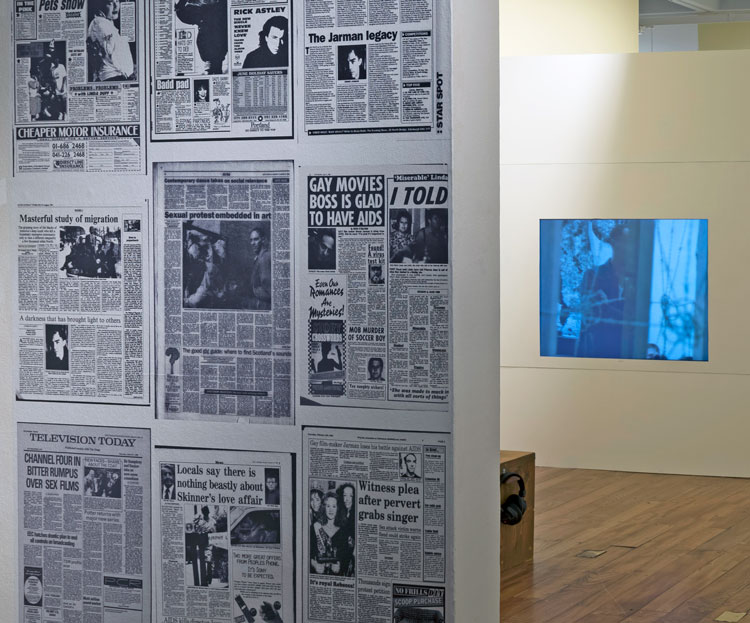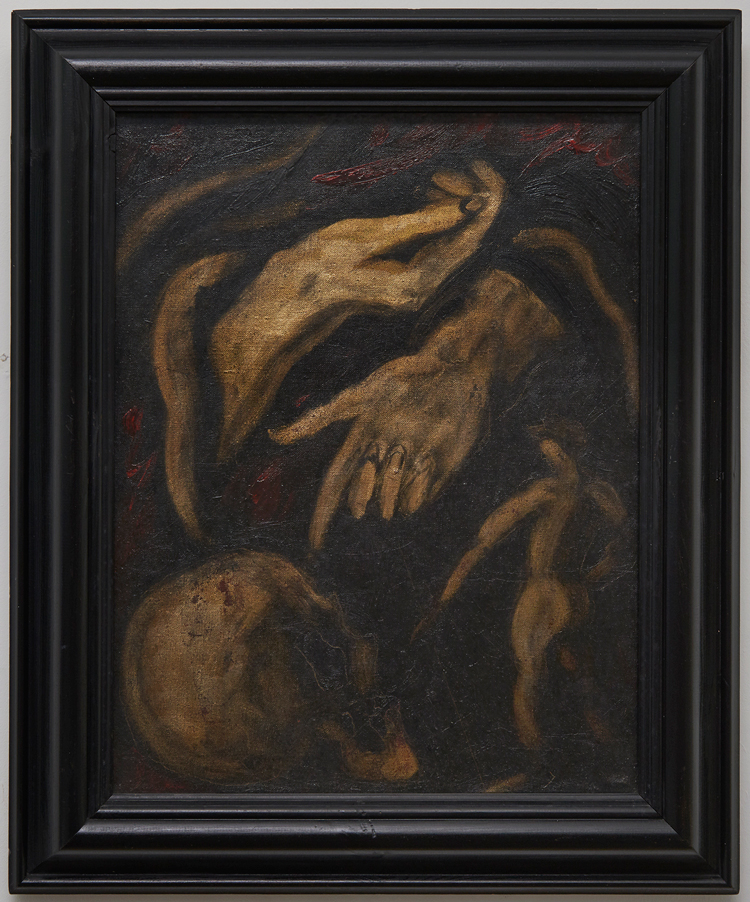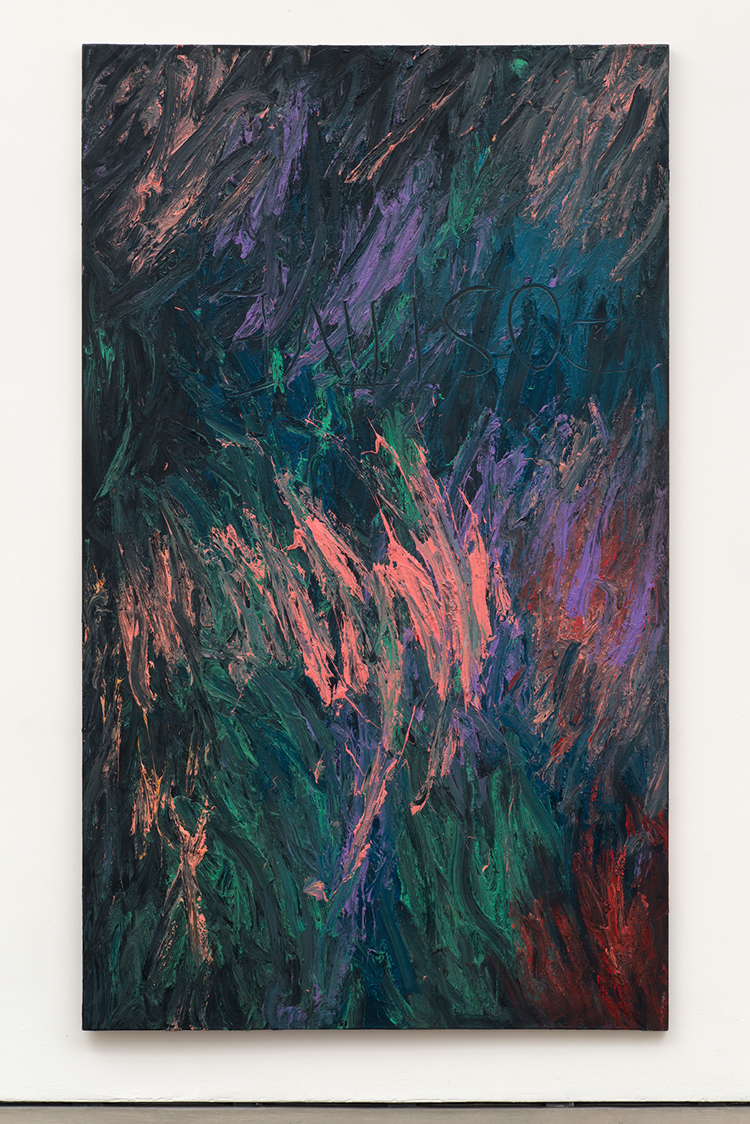
The Hunterian Art Gallery, Glasgow
2 November 2024 – 4 May 2025
by BETH WILLIAMSON
You may not associate the renowned film-maker, artist, set designer and writer Derek Jarman (1942-94) with the city of Glasgow. I for one did not make that connection before this exhibition. Yet as the exhibition and its curator, Dominic Paterson, make clear, it was a performance-installation at Glasgow’s Third Eye Centre (now the Centre for Contemporary Arts) in 1989 that was the springboard for much of Jarman’s art and queer activism. The controversial exhibition featured two men sleeping in a bed surrounded by homophobic newspaper cuttings and barbed wire. The urgent angry scene engaged head-on with the dark shadow of death and loss that hung over the decade like a shroud. The Aids epidemic was killing Jarman’s friends and loved ones, and now it was killing Jarman. In diaries of 1989-90, published as Modern Nature (1991), he recorded his thoughts, including on the Third Eye performance, his garden at Prospect Cottage in Dungeness, and his preparatory work for the films The Garden (1990) and Blue (1993). As an openly HIV-positive man in a homophobic environment, Jarman’s approach to making was, perhaps, a repost to homophobia by living creatively.

Digging in Another Time: Derek Jarman’s Modern Nature, installation view, The Hunterian Art Gallery, Glasgow, 2 November 2024 – 4 May 2025.
When Paterson was invited by artists Rebecca Wilcox and Oliver Pitt to make new work in response to the archive at the Third Eye Centre, his contribution to the 2012 exhibition What We Have Done, What We Are About to Do (Centre for Contemporary Art, Glasgow) consisted of 600 postcards engaging with Jarman’s 1989 installation. I don’t suppose Paterson realised it at the time, but that was also the beginning of the present exhibition, Digging in Another Time: Derek Jarman’s Modern Nature. Yet Digging in Another Time doesn’t stop there. Alongside works by Jarman – painting, film and collage/assemblage for the most part – the exhibition also features the work of six contemporary artists who have responded to Jarman’s work. To that end, work by Andrew Black, Luke Fowler, Tom Walker, Matthew Arthur Williams and Sarah Wood sits alongside work by Jarman. A further contemporary response will come in the form of a performance by Jade de Monserrat (working title Mayday: That Sinking Feeling) that will complete the show.
.jpg)
Derek Jarman. Et in Arcadia Ego (Aids Memoir Prospect Cottage), 1992. Oil on canvas with black metal foil, 40.6 x 40.6 x 3 cm. Courtesy Keith Collins Will Trust and Amanda Wilkinson, London.
If Jarman described himself as a painter who made films, then artist Black is a film-maker who makes paintings. The four new paintings Black made for this exhibition are consciously homoerotic images using collage and fade techniques in a 4:3 ratio. Included in the images are sprigs of beautiful bog asphodel. Yet the pretty plant is deadly to lambs and a reminder of danger in the world wherever we are. The poetics of Fowler’s film Being Blue, shot at Prospect Cottage, comes in its conjunction of closeup shots inside the cottage and panning shots across the world beyond the window. The power of the wind in the sand dunes is apocalyptic, a virus (HIV) ripping through the land with a maelstrom of life and death left in its wake. For his contribution to the exhibition, Walker presents newly edited footage from Jarman’s Third Eye installation-performance in 1989. Tantalisingly, he cuts away each time Jarman appears so that we see the surroundings rather than the artist himself. Presenting Jarman as a just-out-of-reach visionary in 2024 lends the film something of an embers-of-empire feeling and a reminder, if it were needed, that the world is still often hostile. Of course, as a creative response to a visionary work of almost four decades ago, it is also a reminder of the good in the world. The photography of Williams is rooted in empire, as well as questions of wealth and access. Williams places photographs in situ within the walls of one of Glasgow’s 19th-century buildings – the original Royal Conservatoire of Scotland founded in 1847 as part of the Glasgow Athenaeum, I believe – one we would not normally have access too. References to the composers Julius Eastman and Morton Feldman play with scale and layers of history within the image. Wood works with documentary images, scrutinising the line between individual memory and narration of history. Using archival footage from Jarman’s archive, she expands beyond the archive, constructing her narrative around the book Beautiful Flowers and How to Grow Them (a large Edwardian gardening book by Horace J Wright and Walter P Wright that was given to the Jarman by his parents shortly after his fourth birthday). As De Monserrat’s performance is yet to come, I cannot comment on that here.

Derek Jarman. Men asleep are labourers and co-workers in what takes place in the world, 1983. Oil and mixed media on canvas, 45.7 x 35.6 x 2 cm (18 x 14 x 3/4 in). Courtesy Keith Collins Will Trust and Amanda Wilkinson, London.
Jarman’s own work included in this exhibition is bracketed around his diagnosis. The dark pictures of the 80s are more complex than they may at first appear. Sometimes he used gold leaf, painted and scraped. There is often the absence of an image as such, although the painting is still fulsome, using the same vocabulary as Blue and evidencing the dialogue between painting and film in his work. There is the use of figure and text too. Jarman found new ways to articulate persistent themes in his work through film, writing and painting. He references the homophobic culture surrounding an Edenic queer culture. The apocalyptic GBH series of paintings recall the work of Goya, and his collaged paintings include found objects such as stones, driftwood, bones and other small objects found at Dungeness.

Derek Jarman. Positive, 1992. Oil on canvas, 251.5 x 149 cm. Courtesy Keith Collins Will Trust and Amanda Wilkinson, London.
On Sunday 14 May 1989, Jarman wrote: “Dungeness has luminous skies: its moods can change like quicksilver. A small cloud here has the effect of a thunderstorm in the city; the days have a drama that I could never conjure up on an opera stage.” The sensitivity and fragility of the Dungeness landscape and ecosystem might be considered a metaphor for Jarman’s illness and for his creative practice as his work sent shockwaves through the cultural scene simply by being honest. Reclaiming Jarman’s work for the 21st century, and including such considered contemporary responses to that work, Paterson has created what is probably the best exhibition I have seen at the Hunterian Art Gallery in recent years. On a narrow strip of wall space just outside of the list, Paterson has wallpapered the space with copies of the homophobic newspapers that appeared in Jarman’s original installation-performance in 1989, shocking to see in 2024. It’s a little bit of history reconsidered in a manner that is candid, creative and poetic all at once. Don’t miss it.
Berlin. Cosmopolitan: The Vanished World of Felicie and Carl Bernstein
This small but insightful show puts the spotlight on a microcosm within Berlin’s art world at the ...
Emma Talbot – interview: ‘I imagine the experience of life as an epic...
Large installations, paintings on silk, fabric sculptures and drawings convey the connection between...
To mark its 40th birthday, Ditchling Museum of Art + Craft is hosting an exhibition all about reachi...
Mike Nelson: Humpty Dumpty, a transient history of Mardin earthworks low r...
From the architecture of an old hilltop city in Turkey to the demolished Heygate Estate in south Lon...
Jenny Saville: The Anatomy of Painting
Jenny Saville: This astounding show brings together the very best of an incomparable artist: absorbi...
From a mother bathing her children to cleaners working at the gallery, Margaret Salmon gives voice t...
Slavs and Tatars: The Contest of the Fruits
Rapping fruit, legendary birds and nail art feature in the UK debut of the Berlin-based collective S...
Liverpool Biennial 2025: Bedrock
From Sheila Hicks’s gemstone-like sculptures to Elizabeth Price’s video essay on modernist Catho...
Mikhail Karikis – interview: ‘What is the soundscape of the forthcomin...
Mikhail Karikis explains the ideas behind his new sound and video installation calling for action ag...
Art & the Book* and Spineless Wonders: The Power of Print Unbound**
Two concurrent exhibitions bring special collections into broader spaces of circulation, highlightin...
Focusing on the skills of wallpaper design and embroidery, this exhibition tells the story of the ...
Daphne Wright: Deep-Rooted Things
This show is a celebration of the domestic, and the poignant sculpture of Wright’s two sons, now o...
Anna Boghiguian: The Sunken Boat: A Glimpse into Past Histories
The venerable Egyptian Canadian installation artist Anna Boghiguian brings shipwrecks, shells and th...
Abstract Erotic: Louise Bourgeois, Eva Hesse, Alice Adams
A groundbreaking New York show from 1966 is brought back to life with the work of three women whose ...
Jeremy Deller – interview: ‘I’m not looking for the next thing. I...
How did he go from asking a brass band to play acid house to filming former miners re-enacting a sem...
Encounters: Giacometti x Huma Bhabha
The first of three exhibitions to position historic sculptures by Alberto Giacometti with new works ...
The Parisian scenes that Edward Burra is known for are joyful and sardonic, but his work depicting t...
The 36th Ljubljana Biennale of Graphic Arts: The Oracle
Surprising, thrilling, enchanting – under the artistic direction of Chus Martínez, the works in t...
It’s Terrible the Things I Have to Do to Be Me: On Femininity and Fame ...
In a series of essays about pairs of famous women, the cultural critic Philippa Snow explores the co...
Paul Thek: Seized by Joy. Paintings 1965-1988
A rare London show of elusive queer pioneer Paul Thek captures a quieter side of his unpredictable p...
This elegantly composed exhibition celebrates 25 years’ of awards to female artists by Anonymous W...
The first of its kind, this vast show is a stunning tour of the realism movement of the 1920s and 30...
Maggi Hambling: ‘The sea is sort of inside me now … [and] it’s as if...
Maggi Hambling’s new and highly personal installation, Time, in memory of her longtime partner, To...
Caspar Heinemann takes us on a deep, dark emotional dive with his nihilistic installation that refer...
Complex, multilayered paintings and sculptures reek of the dark histories of slavery and colonialism...
Shown in the context of the historic paintings of Dulwich Picture Gallery, Rachel Jones’s new pain...
William Mackrell – interview: ‘I have an interest in dissecting the my...
William Mackrell's work has included lighting 1,000 candles and getting two horses to pull a car. No...
Marina Tabassum – interview: ‘Architecture is my life and my lifestyle...
The award-winning Bangladeshi architect behind this year’s Serpentine Pavilion on why she has shun...
A cabinet of curiosities – inside the new V&A East Storehouse
Diller Scofidio + Renfro has turned the 2012 Olympics broadcasting centre into a sparkling repositor...
Plásmata 3: We’ve met before, haven’t we?
This nocturnal exhibition organised by the Onassis Foundation’s cultural platform transforms a pub...